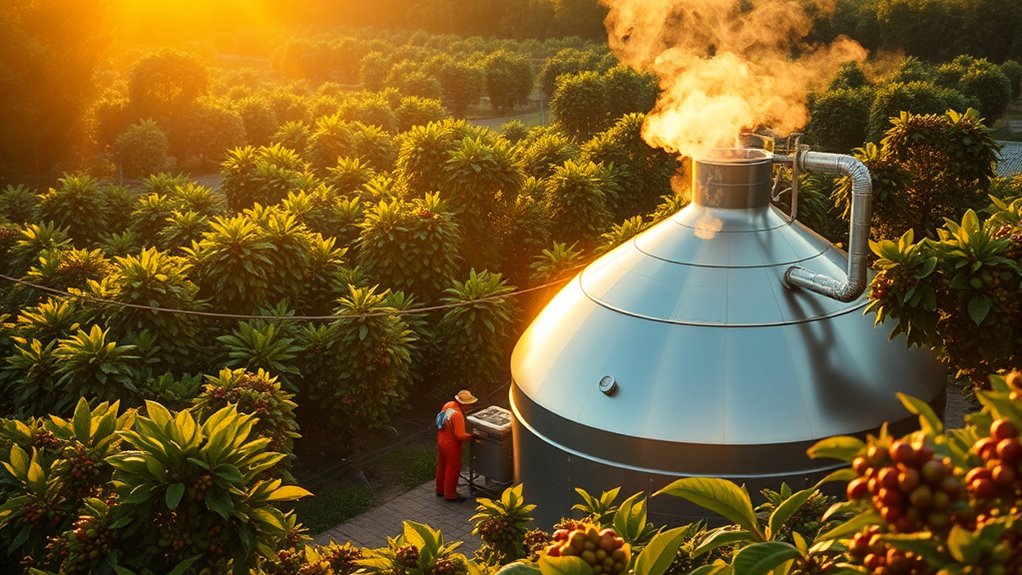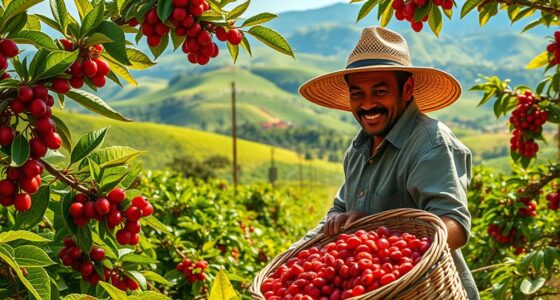Using a biodigester on your coffee farm helps turn coffee pulp waste into renewable energy, reducing water pollution and environmental harm. It employs anaerobic digestion, converting organic waste into biogas that can power farm operations and produce nutrient-rich fertilizer. This process lowers costs, minimizes waste, and promotes sustainable farming practices. If you continue exploring, you’ll discover practical steps and success stories to help you implement this eco-friendly technology effectively.
Key Takeaways
- Biodigesters convert coffee pulp waste into biogas, providing renewable energy for farm operations.
- Proper waste collection and storage enhance biogas production and reduce environmental pollution.
- Anaerobic digestion in biodigesters breaks down pulp, generating energy and nutrient-rich digestate as fertilizer.
- Using biogas on farms decreases reliance on external fuels, lowering operational costs and emissions.
- Regular maintenance ensures biodigester efficiency, prolongs lifespan, and maximizes power generation from pulp waste.
The Environmental Impact of Coffee Pulp Waste
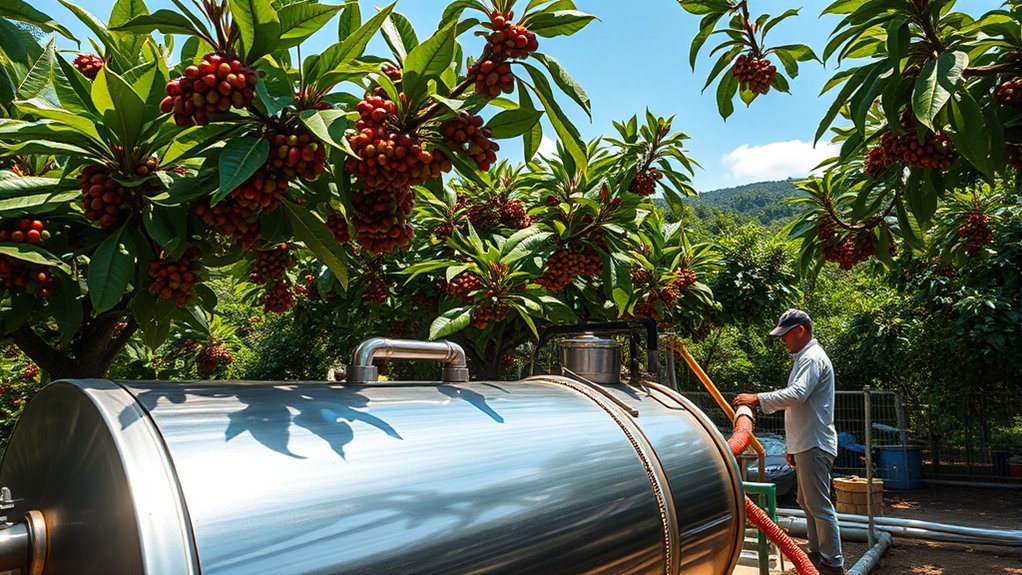
Coffee pulp waste, if not properly managed, can cause significant environmental problems. When left untreated, it often ends up in water bodies, leading to water pollution that harms aquatic life and contaminates drinking water sources. Pulp composting offers a sustainable way to manage this waste, transforming it into valuable organic fertilizer instead of letting it pollute the environment. Without proper disposal methods like composting, the high organic content of coffee pulp can deplete oxygen in water, creating dead zones and disrupting ecosystems. Managing coffee pulp waste responsibly helps prevent water pollution and promotes healthier farms. By turning pulp into compost, you reduce environmental harm and support sustainable coffee production practices, benefiting both local ecosystems and your farm’s long-term health. Additionally, utilizing color accuracy in processing and waste management can improve the visual assessment of compost quality, ensuring better environmental outcomes.
How Biodigesters Work on Coffee Farms
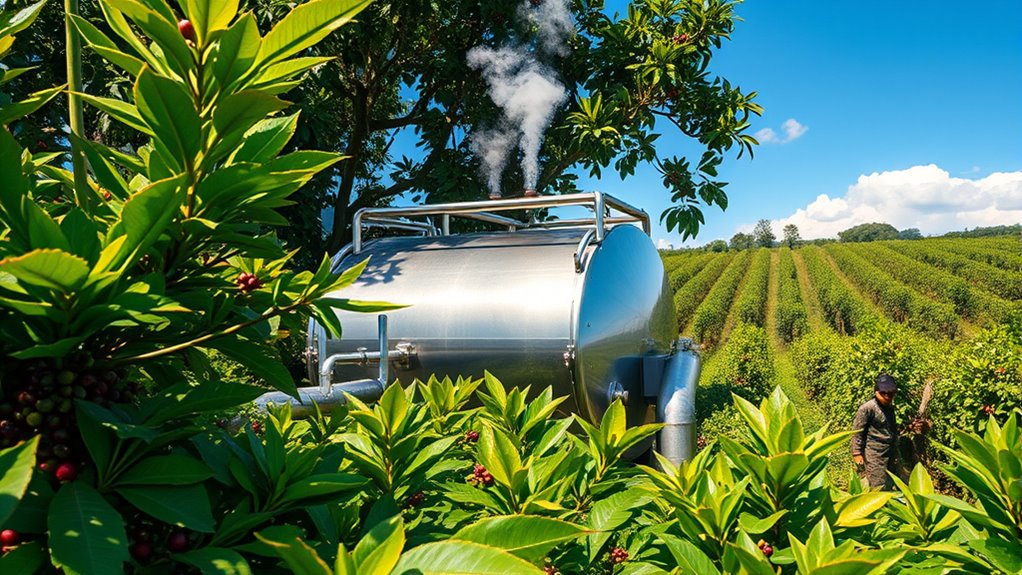
Biodigesters on coffee farms use an anaerobic digestion process to convert organic waste into biogas and nutrient-rich slurry. You collect waste like coffee pulp and manure in sealed chambers, which creates the right environment for microbes to break down the material. The biogas produced can then be used for energy, reducing reliance on external fuel sources. Safer, Durable Wooden Sorting & Stacking Toys are often used on farms to help children learn about sustainability and the environment while playing.
Anaerobic Digestion Process
When organic waste is placed into a sealed chamber, microorganisms break down the material in the absence of oxygen, producing biogas and nutrient-rich slurry. This is the anaerobic digestion process, where microbial activity drives the breakdown of pulp waste. During fermentation, microbes consume the organic matter, releasing methane and carbon dioxide—your biogas—used for energy. The process occurs in stages, starting with hydrolysis, then acidogenesis, acetogenesis, and finally methanogenesis. Each step transforms complex compounds into simpler molecules, fueling ongoing microbial activity. As a result, you generate renewable energy and a valuable digestate that can be used as fertilizer. This natural, biological process efficiently converts waste into power, making biodigesters a sustainable solution for coffee farms.
Waste Collection Methods
To keep the anaerobic digestion process running smoothly, effective waste collection is essential. You should start by implementing composting techniques to manage organic waste properly, guaranteeing the biodigester receives the right materials. Waste segregation plays a crucial role, so separate pulp waste from other farm debris to prevent contamination and optimize digestion. Regular collection of fresh pulp and manure prevents odors and maintains a steady supply of feedstock. Using clear containers or designated bins helps keep waste organized and accessible. Properly stored waste also reduces pests and minimizes environmental impact. Consistent collection routines ensure the biodigester stays fed with high-quality material, maximizing biogas production and farm efficiency. Efficient waste collection methods are vital to turning pulp waste into power effectively. Additionally, employing proper waste management practices can enhance overall farm sustainability and support the biodigester’s longevity.
Biogas Energy Use
By breaking down organic waste through anaerobic digestion, biodigesters convert pulp and manure into biogas, a renewable energy source. You can use this biogas to power farm operations, reducing reliance on fossil fuels and lowering costs. Utilizing biogas not only cuts emissions but also creates a sustainable energy loop on your coffee farm. Better energy management can help maintain ideal conditions for coffee plants, which directly impacts coffee flavor and bean quality. When your farm efficiently harnesses biogas energy, it supports consistent processing and drying, preserving the beans’ aroma and taste. Overall, biogas use from biodigesters makes your coffee production more eco-friendly and economically viable, ensuring high-quality beans with superior flavor profiles. This sustainable approach benefits both your farm’s productivity and environmental footprint.
Benefits of Using Biodigesters for Coffee Growers

Using biodigesters offers numerous advantages for coffee growers. First, they improve biodigester efficiency by effectively converting coffee pulp reuse into biogas, reducing waste and generating energy. Second, you can cut costs by decreasing reliance on external energy sources, turning coffee pulp waste into a valuable resource. Third, biodigesters help manage waste responsibly, minimizing environmental impact and preventing pollution. This sustainable approach not only boosts your farm’s eco-friendliness but also provides a reliable source of biogas for your activities. Additionally, the process promotes better farm hygiene and reduces pests associated with decomposing pulp. Overall, adopting biodigesters enhances farm productivity, environmental health, and resource management, making them a smart investment for coffee growers aiming for sustainable, efficient operations.
Step-by-Step Guide to Installing a Biodigester
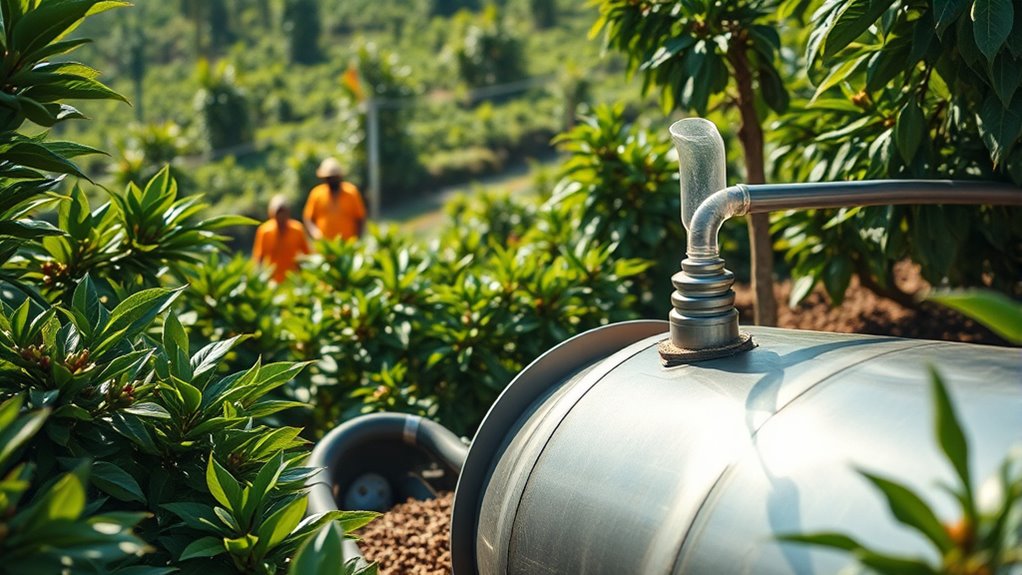
Are you ready to install a biodigester on your coffee farm? First, choose a suitable location away from water sources and coffee plants. Prepare the digester tank, making sure it’s sealed and airtight for efficient digestion. Connect inlet pipes for pulp waste and outlet pipes for organic fertilizers. Then, add fresh pulp waste regularly to start the process. Remember, proper installation supports sustainable coffee cultivation by reducing waste and producing organic fertilizers. Use the table below to guide your steps:
| Step | Action | Tips |
|---|---|---|
| Select Location | Find a flat, shaded area | Avoid flooding risks |
| Install Tank | Secure tank and connect pipes | Make certain it’s airtight seal |
| Add Waste | Fill with fresh pulp waste | Mix regularly |
| Maintain System | Monitor for leaks and proper flow | Keep organic fertilizers flowing |
This straightforward setup helps turn pulp waste into power efficiently, vibrational energy that aligns with sustainable practices.
Managing and Maintaining Biodigesters Effectively
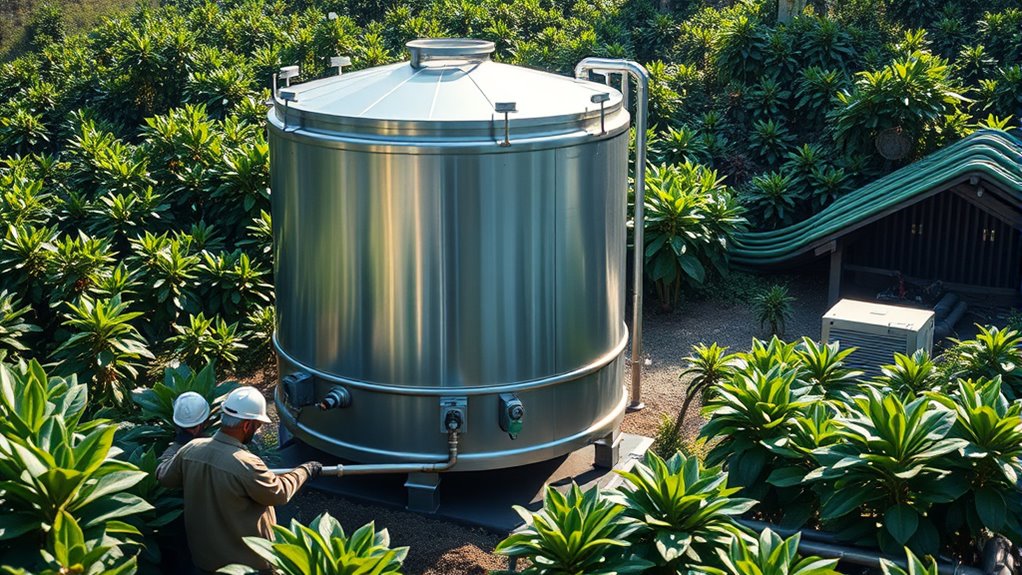
To keep your biodigester functioning efficiently, regular management and maintenance are essential. Proper oversight ensures consistent biogas production and prevents issues.
Here are three key steps:
- Monitor for pest control issues that could compromise the system or attract pests near your farm.
- Regularly inspect the inlet and outlet pipes to prevent blockages and ensure smooth digestion.
- Practice crop rotation to reduce pathogen buildup and maintain healthy feedstock supply.
Additionally, keep the biogas chamber clean and avoid overloading it with waste. Maintaining ideal temperature and pH levels helps sustain microbial activity. Juice cleansing practices can influence the microbial health of your biodigester, so avoid introducing high-sugar or overly processed waste that might disrupt microbial balance. Consistent management minimizes downtime and prolongs your biodigester’s lifespan, making it a reliable energy source for your coffee farm.
Case Studies: Successful Biodigester Implementations
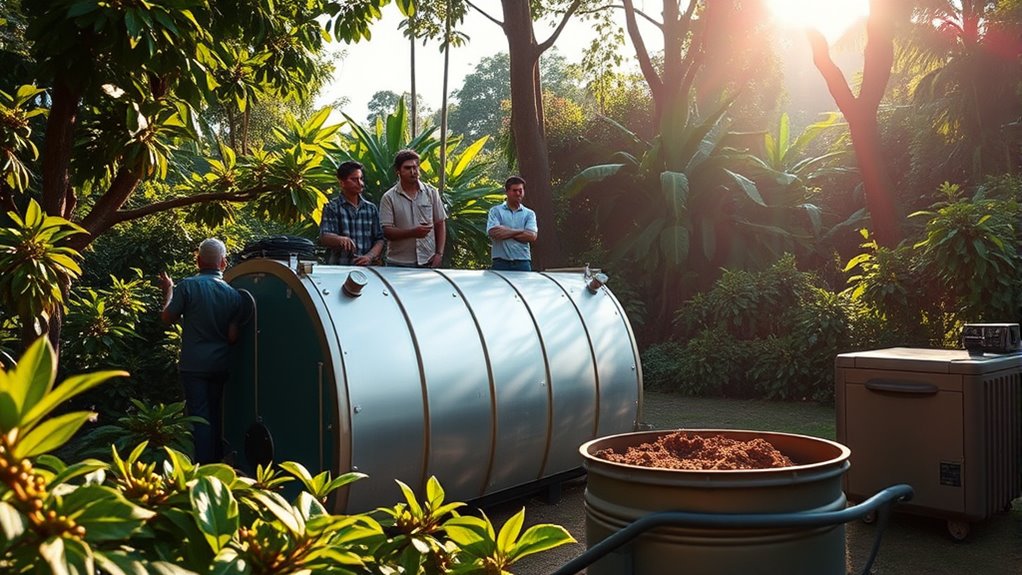
Many coffee farms have successfully implemented biodigesters, demonstrating their practicality and benefits in real-world settings. For example, some farms have integrated biodigesters to process pulp from coffee bean fermentation, turning waste into useful biogas for farm operations. These farms have also improved pulp composting practices by capturing gases that would otherwise be released into the environment. One notable case involved a farm that reduced waste volume considerably while generating enough energy to power processing equipment. The biodigester’s ability to handle pulp waste efficiently proved essential in reducing environmental impact and lowering costs. Additionally, understanding the waste management practices involved helps optimize the biodigester’s performance and sustainability. These real-world examples show that biodigesters can be a practical solution, turning coffee pulp waste into valuable resources, and highlighting their role in sustainable coffee farming.
Economic Advantages of Converting Pulp Waste Into Energy

Converting pulp waste into energy offers significant economic benefits for coffee farms. It can reduce operational costs and create new revenue streams. Market incentives, such as carbon credit programs, encourage farms to adopt biodigesters, providing financial rewards for sustainable practices. Additionally, government subsidies are often available to offset installation costs, making the switch more affordable. Here are three key advantages: 1. Lower energy expenses, decreasing overall operating costs. 2. Access to government grants and subsidies, easing initial investments. 3. Potential income from selling excess energy or carbon credits, boosting farm profitability. Utilizing precious metals in investment strategies can further enhance financial security by providing a hedge against market volatility.
Future Perspectives on Sustainable Coffee Farming
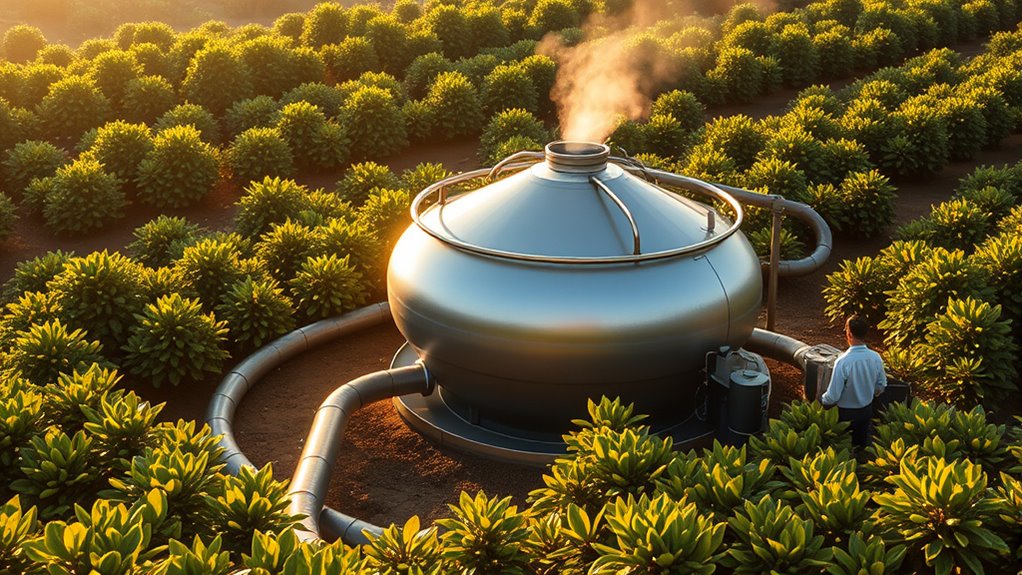
As you look ahead, integrating renewable energy sources can make coffee farming more sustainable and less dependent on external power. Circular waste management practices, like using biodigesters, help reduce environmental impact and improve farm efficiency. Embracing eco-friendly farming methods will be vital to building resilient, sustainable coffee production systems for the future. Utilizing eye patch benefits in farm health routines can also promote better recovery and maintenance for workers exposed to long hours.
Renewable Energy Integration
Integrating renewable energy sources into coffee farming is shaping the future of sustainable agriculture by reducing reliance on fossil fuels and lowering environmental impacts. This shift can enhance both coffee flavor and farm aesthetics, creating a more appealing environment for workers and visitors. Here are three key benefits:
- Enhanced Coffee Quality: Renewable energy reduces emissions that can affect bean development, resulting in richer flavor profiles.
- Aesthetic Improvements: Solar panels and wind turbines can be seamlessly integrated into the landscape, preserving the farm’s natural beauty.
- Cost Savings and Resilience: Less dependence on external energy boosts resilience to price fluctuations and grid outages, ensuring consistent production. Dog names are also a popular way to personalize and add character to the farm environment, sometimes reflecting the farm’s heritage or the worker’s preferences.
Circular Waste Management
How can circular waste management revolutionize sustainable coffee farming in the future? By closing the loop on waste, you can transform pulp and husks into valuable resources, reducing environmental impact. Recycling coffee pulp into compost enriches soil, which enhances bean quality and promotes healthier plant growth. This approach minimizes waste disposal costs and supports resource efficiency. When waste is managed circularly, it prevents nutrient runoff, maintaining soil health and ensuring consistent coffee flavor. You’ll notice improved bean quality, as healthier plants produce better-tasting beans. Circular waste management also fosters resilience against resource scarcity, making your farm more sustainable long-term. Embracing this model helps you create a closed-loop system where waste becomes a beneficial input, ensuring the future of coffee farming remains environmentally sound and economically viable. Additionally, implementing natural materials in farm infrastructure can further enhance sustainability and reduce reliance on non-renewable resources.
Eco-Friendly Farming Practices
Building on circular waste management, adopting eco-friendly farming practices can considerably boost the sustainability of coffee farms. These practices focus on natural methods to enhance soil enrichment and promote water conservation. By implementing cover cropping, you improve soil health and reduce erosion. Using organic fertilizers minimizes chemical runoff, supporting healthier ecosystems. Additionally, employing drip irrigation systems conserves water while ensuring plants receive adequate moisture. These strategies not only protect the environment but also increase crop resilience and productivity. To embrace eco-friendly farming, consider:
- Planting cover crops to enrich soil naturally
- Using organic fertilizers to reduce chemical use
- Installing water-saving irrigation methods to conserve resources
Adopting these practices helps create a sustainable, environmentally responsible coffee farm that benefits both your business and the planet.
Frequently Asked Questions
What Are the Long-Term Environmental Benefits of Biodigester Adoption?
Long-term, adopting biodigesters benefits your environment by improving soil health through nutrient-rich digestate, reducing reliance on chemical fertilizers. It also boosts biodiversity by decreasing pollution and habitat disruption caused by waste runoff. You’ll help mitigate greenhouse gas emissions, promote sustainable farming, and protect ecosystems. Overall, biodigesters foster a healthier, more resilient environment, ensuring your farm’s sustainability and contributing to broader ecological balance.
How Does Biodigester Maintenance Affect Its Efficiency and Lifespan?
Think of your biodigester like a machine needing regular care. If you maintain it well, especially by monitoring feedstock quality, it runs efficiently and lasts longer. For example, a coffee farm that troubleshoots issues early prevents system breakdowns. Regular cleaning and checking for clogs ensure maximum gas production. Neglecting maintenance can decrease efficiency and shorten its lifespan, so stay proactive with troubleshooting and feedstock management.
Are There Any Government Incentives for Implementing Biodigesters on Coffee Farms?
You might find government grants and policy support helpful when implementing biodigesters on your coffee farm. Many governments encourage sustainable practices and offer financial incentives to promote renewable energy solutions. These programs can cover installation costs or provide ongoing subsidies, making it easier for you to adopt biodigesters. Checking local agricultural or environmental agencies’ websites can help you discover available incentives and guarantee you meet the necessary requirements to qualify.
Can Biodigester Technology Be Scaled for Small Versus Large Coffee Operations?
You wonder if biodigester technology can be scaled for small and large coffee operations. It’s possible, but cost considerations and technological adaptability matter. Small farms might face higher costs per unit, but simpler designs can help. Larger farms benefit from economies of scale, making biodigesters more affordable. Overall, with adaptable technology and strategic planning, both small and large farms can implement biodigesters effectively, turning waste into valuable energy.
What Challenges Might Farmers Face When Transitioning to Biodigester Systems?
When shifting to biodigester systems, you might face challenges like financial hurdles, which can make initial setup costly. Additionally, technical training is essential to operate and maintain the system properly, and finding skilled personnel can be tough. You’ll need to plan for these hurdles, seek financial support or subsidies if available, and invest in proper training to guarantee smooth adoption and long-term success of the biodigester on your farm.
Conclusion
By embracing biodigesters, you gently transform coffee pulp waste into a valuable resource, nurturing both your farm and the environment. This subtle shift not only reduces ecological footprints but also unleashes new opportunities for sustainable growth. As you explore this innovative path, you’ll find that turning waste into energy is a quiet revolution—one that promises a brighter, greener future for your coffee journey. Embrace the change and watch your farm flourish with harmony and purpose.
